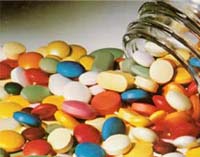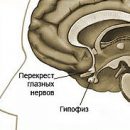Treatment of hyperparathyroidism depends on the form of the disease. Primary hyperparathyroidism is treated operational way. During the crisis, medication therapy is appointed. To reduce the release of calcium and improving its fixation in the bones, calciteonine is prescribed.
Content
Methods of treatment of hyperparathyroidism
With primary hyperparathyroidism, treatment operational - removal of pararatyroenoma. With the hyperplasia of the nearish glands, three puzzles are removed with a fourth resection or a complete removal with subsequent intramuscular implantation.
Relative contraindications for surgery are perforation of stomach and bleeding ulcers, acute renal failure, exacerbation of pancreatitis. Absolute indication for emergency operation - hypercalcemic crisis.
Medicia treatment
 If an emergency operation is impossible for hypercalcemic crisis, prescribed immediately drug therapy aimed at reducing calcium content in the blood. At the first stage of the treatment of a crisis in the absence of pronounced dehydration and renal failure with oliginia, forced diuresis. During the first 1.5-2 hours, intravenously drip 1,5-2 liters of isotonic sodium solution chloride, which increases the glomerious excretion of calcium. Then, against the background of the continuing infusion of this solution (at a speed of 500 ml / h), each hour is administered intravenously 80-100 mg of furosemide under the control of the diurea using a constant catheter, potassium content, sodium, magnesium in the blood and central venous pressure (monitor observation). The rate of intravenous administration of isotonic solution of sodium chloride or 5% glucose solution depends on the volume of urine released. For the prevention of hypokalemia to each liter of the solution introduced intravenously, 1.5 g (20 mmol) of potassium chloride are added. Forced diuresis prescribed for a long time (sometimes up to 2 days). The introduction of magnesium sulfate (calcium antagonist) is shown intramuscularly by 10 ml of 25% solution.
If an emergency operation is impossible for hypercalcemic crisis, prescribed immediately drug therapy aimed at reducing calcium content in the blood. At the first stage of the treatment of a crisis in the absence of pronounced dehydration and renal failure with oliginia, forced diuresis. During the first 1.5-2 hours, intravenously drip 1,5-2 liters of isotonic sodium solution chloride, which increases the glomerious excretion of calcium. Then, against the background of the continuing infusion of this solution (at a speed of 500 ml / h), each hour is administered intravenously 80-100 mg of furosemide under the control of the diurea using a constant catheter, potassium content, sodium, magnesium in the blood and central venous pressure (monitor observation). The rate of intravenous administration of isotonic solution of sodium chloride or 5% glucose solution depends on the volume of urine released. For the prevention of hypokalemia to each liter of the solution introduced intravenously, 1.5 g (20 mmol) of potassium chloride are added. Forced diuresis prescribed for a long time (sometimes up to 2 days). The introduction of magnesium sulfate (calcium antagonist) is shown intramuscularly by 10 ml of 25% solution.
In the absence of renal failure for binding calcium and its removal from the blood, sodium citrate or sodium sulfate is used. Sodium citrate is prescribed intravenously 250 ml of 2.5% solution, and sodium sulfate - intravenously 3000 ml of solution for 8-10 hours. Instead of sodium citrate and sodium sulfate, phosphates are used, used 0.1 m (pH 7.4) sodium and potassium phosphate buffer, which is administered in a dose of 500 ml (1.5 g of phosphates) intravenously droplet for 6-8 hours. Along with intravenous administration, phosphates can be appointed inside in tablets (daily dose 3-4 g). In the intravenous introduction of phosphates due to the rapid formation of calcium phosphate, massive calcifications in the lungs, myocardium and kidneys are possible. This may be the cause of acute heart or kidney failure with death. An effective drug for calcium binding in the blood is also sodium salt of ethylenediaminetetraacetic acid (Na EDTA). It is introduced intravenously drip at the rate of 50 mg / kg in 200-250 ml of a 5% glucose solution for 4-8 hours in a total dose, not exceeding 2-2.5 g.
In the intravenous conduct of large doses of the drug, arterial hypotension may occur, glomerulonecosis with the development of acute renal failure, as well as massive hemorrhages in parenchymal organs. In the absence of renal and liver failure in some cases, Mitramycin is used. The latter is a cytotoxic antibiotic that hinders the activity of osteoclasts. The greatest effectiveness of mitramycin is noted with primary hyperparathyroidism, pseudo-opporathyroidism and hypercalcemia due to bone metastases of malignant tumors. The drug is introduced intravenously at the rate of 25 μg / kg. In the chronic form of hypercalcemia, it can be used at a dose of 10-12 μg / kg 1-2 times a week.
When prescribing mitramicine, the maximum effect occurs only on the 2nd -5 day, so in the treatment of a hypercalcemic crime, it is advisable to apply it in combination with high-speed drugs. Mitramicin often causes nausea, vomiting, disorders of the kidney function, braking of bone marrowing and hemokoagulation (thrombocytopenia). To reduce the absorption of calcium in the intestine and increasing the excretion of calcium with urine, glucocorticoids are prescribed. Under the influence of glucocorticoids, the calcium content in the blood decreases slowly, so in the treatment of hypercalcemic crisis, they are used only in combination with other drugs. In the hypercalcemic crisis, glucocorticoids are usually added to the infusion system. Prednisolone 4-90 mg per day or hydrocortisone in an equivalent dose. Glucocorticoids are effective in hypercalcemia due to myeloma disease, leukose, sarcoidosis and vitamin D intoxication.
To reduce the release of calcium and improving its fixation in the bones, calcitonin is prescribed, which has a rapid, but not sufficiently pronounced calcium effect effect. Therefore, calcitonin is advisable to combine with GLCLCorticoids and Mitramycin. Calcitonine is used intravenously drip at the rate of 5-10 meters per 1 kg of body weight per day in 500 ml of isotonic sodium chloride solution. The drug is injected for 6 hours in 2-4 reception during the day. In chronic conditions, calcitonin is administered subcutaneously or intramuscularly at the rate of 5-10 me / kg per day in 1-2 reception. Due to the rapid development of resistance to the drug (usually 2-3 days from the beginning of its application), the combination with glucocorticoids becomes even more relevant. In these cases, prednisone is prescribed 15-20 mg per day or hydrocortisone in an equivalent dose.
With the development of a hypercalcemic crise due to excessive synthesis of prostaglandin E (PGE) a tumor, the blockers of its synthesis are prescribed - indomethacin of 25 mg each 6 h or acetylsalicylic acid is 0.5 g every 4-6 h.
Cardiovascular disorders and dehydration are eliminated by conducting symptomatic therapy shown in these cases. If drug therapy turns out to be ineffective or there are contraindications to the operation, it is usually used peritoneal dialysis or hemodialysis with infals dialysate.
The patient diet should consist of products, poor calcium. In this regard, milk, dairy products, vitamin D exclude from the food diet.
Under the Tetania in the postoperative period, the patient is administered intravenously 10-50 ml of a 10% calcium solution chloride or calcium gluconate and intramuscularly or subcutaneously 40-100 units pararatyridine. In some cases (with a weakly rehabited Tetania), calcium drugs can be prescribed. For better assimilation of calcium and postponement of it in the bones, vitamin D2 and dihydroitachster are used. Instead of vitamin D2 and dihydroratakhinterol, very effective preparations of vitamin D3-1- (OH) 2-D3 and 1.25- (OH) 3-D3 can be used, the maximum biological effect of which manifests itself after 3-6 days, while drugs Vitamin D2 and dihydroitacterol - after 2-4 weeks. Such treatment is carried out within 1-3 months after surgery under the control of the blood content of calcium, phosphorus and potassium. In order to avoid overdose of vitamin D and hypercalcemia, insolation should be avoided. The patient's food must contain a large amount of calcium and phosphorus (cottage cheese, milk, cheese, etc.).
Forecast with hyperparathyroidism
The forecast for hyperparathyroidism largely depends on early diagnosis and timely treatment. In the operational treatment of the bone form of the hyperparathyroidism, the forecast is usually favorable. Restoration of the ability of patients with this form of the disease depends on the degree of damage to the bone system. In notable cases, ability to be restored after the operation is usually for 3-4 months, with a severe current - during the first 2 years. With the renal form of hyperparathyroidism, the forecast is less favorable. Disability depends largely on the degree of kidney damage before surgery. Without operational treatment, patients with primary hyperparathyroidism, as a rule, become disabled and dying usually from increasing cachexia and renal failure. Forecast with hypercalcemic crisis depends on the timeliness of diagnosis and treatment.









